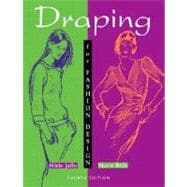
| Foreword | |
| Preface | |
| Introduction | |
| Basic Preparation | |
| Basic Patterns | |
| Bodices | |
| Skirts | |
| Pants | |
| The Midriff and Yokes | |
| Collars | |
| Sleeves | |
| The Shift | |
| The Princess Dress | |
| Sportswear and Casual Wear | |
| Tailored Garments | |
| Functional Finishes | |
| Pockets | |
| Draping in Fabric and Fitting | |
| Appendix: A Conversion of Inches to Centimeters | |
| Selected Bibliography | |
| Index | |
| Table of Contents provided by Publisher. All Rights Reserved. |
The New copy of this book will include any supplemental materials advertised. Please check the title of the book to determine if it should include any access cards, study guides, lab manuals, CDs, etc.
The Used, Rental and eBook copies of this book are not guaranteed to include any supplemental materials. Typically, only the book itself is included. This is true even if the title states it includes any access cards, study guides, lab manuals, CDs, etc.